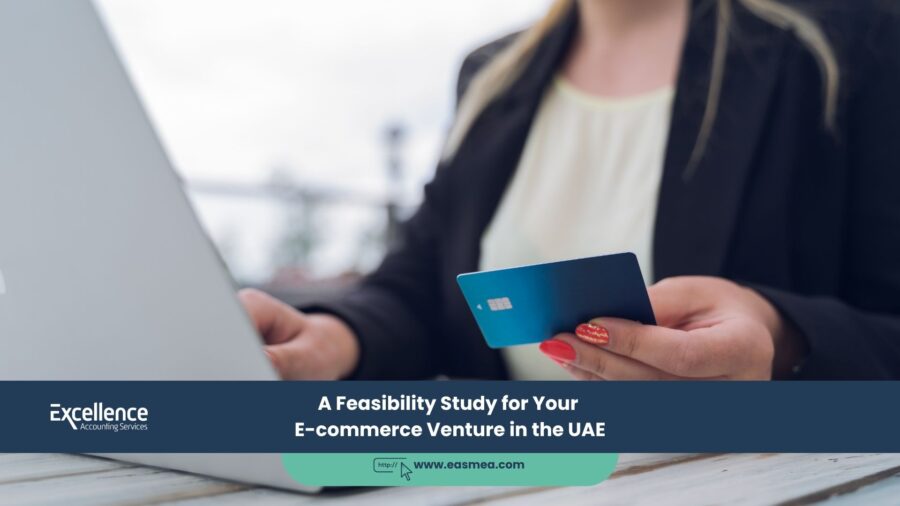A Feasibility Study for Your E-commerce Venture in the UAE
Launching an e-commerce business in the UAE is an incredibly exciting prospect. The region boasts one of the highest internet penetration rates in the world, a digitally savvy consumer base with strong purchasing power, and a government actively fostering a digital economy. However, the allure of this booming market often masks its fierce competitiveness. Success is not guaranteed by simply having a great product and a beautiful website. It requires a rigorous, data-driven plan that proves your venture is not just a good idea, but a viable, profitable, and sustainable business.
- A Feasibility Study for Your E-commerce Venture in the UAE
- Component 1: Market Feasibility – Is There a Customer?
- Component 2: Technical Feasibility – Building Your Digital Storefront
- Component 3: Operational Feasibility – Running the Day-to-Day
- Component 4: Financial Feasibility – The Bottom Line
- Build a Bankable E-commerce Feasibility Study with EAS
- Frequently Asked Questions (FAQs)
- Is Your E-commerce Idea a Business or a Hobby?
This is the role of a Feasibility Study. Before you invest your life savings or seek external funding, a feasibility study acts as your critical, objective reality check. It’s a comprehensive investigation that analyzes your e-commerce concept from every angle—market demand, technical requirements, operational logistics, and financial viability. It is the document that answers the most important question: “Will this actually work?”
This guide is specifically designed for entrepreneurs planning to launch an e-commerce venture in the UAE. We will break down the key components of a bankable feasibility study, focusing on the unique challenges and opportunities of the digital marketplace. This is your blueprint for building a plan that not only guides your strategy but also inspires confidence in investors and lenders.
Key Takeaways
- Feasibility First, Business Plan Second: A feasibility study determines *if* the e-commerce venture is viable; a business plan outlines *how* you will execute it.
- Market Analysis is Crucial: You must prove, with data, that there is a specific, reachable target audience for your products in the UAE.
- Technical Feasibility is Key: Choosing the right e-commerce platform, payment gateway, and logistics partner is a critical decision with long-term cost implications.
- The Financial Model Tells the Story: Your study must include detailed projections of startup costs, digital marketing expenses, and a defensible revenue forecast based on traffic and conversion rates.
- Don’t Forget Compliance: The study must account for legal requirements like company formation, VAT, and Corporate Tax.
- Expert Help is a Strategic Advantage: The complexities of the UAE e-commerce market make professional guidance from business and financial consultants invaluable.
Component 1: Market Feasibility – Is There a Customer?
This is where you prove that a hungry market exists for what you’re selling. An e-commerce market study goes beyond general statistics.
- Niche and Target Audience Analysis: Who is your ideal customer in the UAE? Define them by demographics (age, income, location in Dubai vs. Abu Dhabi, etc.) and psychographics (lifestyle, values, online shopping habits).
- Competitor Analysis: Identify your direct competitors (other online stores selling similar products) and indirect competitors (large marketplaces like Amazon.ae and Noon). Analyze their pricing, marketing strategies, and customer reviews. What will be your unique selling proposition (USP)?
- Market Size and Demand Validation: Use tools like Google Trends, keyword research, and market reports to quantify the demand for your product category in the UAE.
- Pricing Strategy: Determine a pricing model that is competitive yet profitable, considering product costs, shipping, and marketing expenses.
Component 2: Technical Feasibility – Building Your Digital Storefront
This section details the technology and infrastructure required to run your online business.
- E-commerce Platform Selection: This is a major decision. Will you use a SaaS platform like Shopify or a self-hosted solution like Magento/WooCommerce? Your study should compare the costs, features, and scalability of your chosen platform.
- Payment Gateway Integration: Research and select a UAE-based payment gateway (e.g., Telr, PayTabs) to process online payments. The study must include their setup fees and transaction charges.
- Website Development and Design: Outline the costs and timeline for designing and developing your website, including any custom features required.
- Logistics and Shipping Partner: Identify a reliable third-party logistics (3PL) partner in the UAE for warehousing, order fulfillment, and last-mile delivery. Their costs must be factored into your financial model.
Component 3: Operational Feasibility – Running the Day-to-Day
This covers the people and processes needed to manage the business once it’s live.
- Team and Skills: Who will run the business? Outline the key roles (e.g., marketing, customer service, operations) and the skills required. If you are starting solo, be realistic about the tasks you can handle and where you will need freelance or agency support.
- Supply Chain Management: Detail your process for sourcing products, managing inventory levels, and handling returns.
- Customer Service Plan: How will you handle customer inquiries, complaints, and returns? A clear plan for providing excellent customer service is a key differentiator in the UAE market.
- Legal and Administrative: This includes the process for company formation (e.g., a Dubai e-trader license or a Free Zone company), and setting up your bookkeeping and administrative processes.
Component 4: Financial Feasibility – The Bottom Line
This is where you translate all your research into a comprehensive financial model. This is the most scrutinized section of your study.
- Startup Cost Breakdown: A detailed list of all one-time costs: license fees, website development, initial inventory purchase, and initial marketing budget.
- Operating Expense Projections: A monthly forecast of your recurring costs: platform fees, payment gateway charges, digital marketing spend, salaries, and logistics costs.
- Revenue Forecast: A bottom-up forecast based on key e-commerce metrics:
(Monthly Website Traffic x Conversion Rate) x Average Order Value = Monthly Revenue
Your study must justify each of these assumptions with market data. - Projected Financial Statements: A 3-year forecast of your Income Statement, Cash Flow Statement, and Balance Sheet.
- Break-Even Analysis: Calculate the monthly sales volume you need to achieve to cover all your costs.
For an e-commerce business, the Customer Acquisition Cost (CAC) and Lifetime Value (LTV) are critical metrics. Your financial model must show a clear path to achieving a profitable LTV:CAC ratio.
| Feasibility Area | Key Question for E-commerce | Key Output in the Study |
|---|---|---|
| Market | “Who will buy my products online in the UAE and why?” | Target audience profile, competitor analysis, traffic estimates. |
| Technical | “What is the best and most cost-effective tech stack?” | Choice of e-commerce platform, payment gateway, and 3PL partner. |
| Operational | “How will we manage orders, customers, and suppliers?” | Workflow for order fulfillment, customer service plan. |
| Financial | “When will this business become profitable?” | Detailed financial model, break-even analysis, funding requirement. |
Build a Bankable E-commerce Feasibility Study with EAS
The success of your e-commerce launch depends on the quality of your plan. At Excellence Accounting Services (EAS), our team of business and financial consultants specializes in creating data-driven feasibility studies for digital ventures in the UAE.
Our Services for E-commerce Entrepreneurs:
- Comprehensive Feasibility Studies: We conduct in-depth market research and build sophisticated financial models to rigorously test the viability of your e-commerce idea.
- Financial Modeling and Forecasting: We create detailed, assumption-led financial projections that are essential for securing loans or investment.
- Strategic Advisory: We provide expert advice on everything from choosing the right legal structure to selecting technology partners and planning your tax strategy.
- Investor-Ready Documentation: We craft a professional, persuasive report that gives you the confidence to move forward with your venture.
Frequently Asked Questions (FAQs)
While all parts are integrated, the Market Feasibility and Financial Feasibility sections are the most critical. You must first prove there is a market, and then you must prove, with a credible financial model, that you can reach that market profitably.
This is a key challenge. You can build a forecast based on your planned digital marketing spend. For example, you can use industry benchmarks for cost-per-click (CPC) in your niche in the UAE to estimate the traffic you can generate from a specific Google Ads budget.
Average e-commerce conversion rates typically range from 1% to 3%. For a new, unknown brand, it is prudent to be conservative and start your forecast with a conversion rate at the lower end of this range, perhaps 1% or even slightly less, and project it to improve over time as you build brand trust.
This is a key strategic decision that should be addressed in your study. A mainland license (like a Dubai DED e-trader license) allows you to sell directly to customers across the UAE without restriction. A Free Zone license can offer 100% ownership and other benefits, but you may need a third-party distributor for mainland sales. The choice impacts your costs and operational model.
Your cash flow forecast in the financial feasibility study will answer this. It will show your projected monthly cash inflows and outflows. The largest negative cash balance you project during your first year is a good estimate of the minimum working capital you will need to survive before the business becomes cash-flow positive.
The biggest and most frequently underestimated costs are customer acquisition (digital marketing) and logistics (shipping and returns). Your study must be based on real quotes and data for these items, not just guesses.
Your financial model must be tax-aware. Your revenue projections should account for collecting 5% VAT from UAE customers. Your expense projections should factor in the input VAT you can recover. Your final profit projections must then be used to calculate your potential Corporate Tax liability.
No. A feasibility study is an investigative report that determines if the idea is viable. A business plan is a strategic document that outlines how you will execute the idea *after* it has been deemed feasible. You do the feasibility study first.
This is a positive outcome! The study has just saved you from investing significant time and money into a venture that was likely to fail. A negative result allows you to pivot, adjust your model (e.g., find lower-cost suppliers, target a different niche), or move on to a new idea without suffering a major loss.
Yes. A comprehensive, professionally prepared feasibility study with conservative and well-justified financial projections is exactly what banks and financial institutions in the UAE require when assessing a loan application for a new venture.
Conclusion: Your Blueprint for Digital Success
In the fast-moving world of e-commerce, it’s tempting to jump straight into building your website and running ads. But the most successful ventures are built not on speed, but on strategy. A thorough feasibility study is your strategic foundation. It forces you to think critically about every aspect of your business, challenge your own assumptions with data, and build a financial model that is both ambitious and achievable. It is the blueprint that will guide your launch and give you the best possible chance of success in the exciting e-commerce landscape of the UAE.
Is Your E-commerce Idea a Business or a Hobby?
Our expert consultants can help you rigorously test your e-commerce concept and build a financial plan that gets you funded.




